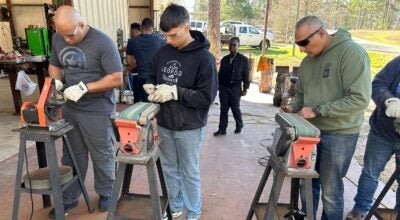Weather tips to help prepare for upcoming freeze
Published 11:29 am Sunday, January 14, 2024

- Tyler Walker at Stine stocks faucet protectors in Lake Charles ahead of freezing temperatures expected in the region. (American Press Archives)
By Emily Burleigh
In preparation for incoming cold weather, government entities are encouraging citizens to take the time to winterize their homes.
Southwest Louisiana will be hit with a wave of freezing temperatures and rain early next week. The National Weather Service Office in Lake Charles said temperatures Monday through Wednesday will be “unusually cold,” with temperatures reaching below freezing.
Winterizing Homes
Kevin Heise, utilities manager, city of Lake Charles, said there are several steps that can be taken to protect a home during freezing weather.
Particular attention should be given to pipes. He said if precautions aren’t taken, homeowners could experience a frozen pipe that could burst and cause damage to the residence.
“Spending just a few minutes walking around your property and through your home with a few specific things in mind can potentially save you from a burst pipe and can even help cut down on the cost of heating your home.”
Dripping faucets is a common practice that homeowners use to prevent their pipes from freezing. However, this is “most likely not necessary” for residences that are built on a slab and are well insulated.
This step is most beneficial for older, less insulated homes. In fact, Heise said that excessive water dripping can be detrimental to the City’s water systems.
“Dripping faucets for an extended period of time is a wasteful use of our water resources and can put a strain on our water system as a whole.”
He said that if every customer in the city of Lake Charles Water Division drips multiple faucets in their residence simultaneously for an extended period of time, the City’s plants have to produce about 50 to 55 million gallons of water a day. This is approximately double the maximum daily production capacity for all City of Lake Charles Water Plants: 22 million gallons a day.
When the city’s water plants exceed maximum capacity, water pressure lowers and water becomes discolored. He continued by saying it is important for citizens to be mindful of their water consumption during freezes to ensure emergency services have access to the resource in case of emergency.
“We always want to ensure we are able to service our hospitals and fire service with sufficient water pressure, and so we ask our residents to assist us in these efforts by being conservative with their water use during these events.”
When dripping faucets, it is best to use a faucet located the furthest from the home’s main water valve. Monitor the faucet regularly and turn it off during the day once the temperature rises above freezing.
Another step that can be taken to care for pipes during a freeze is opening the cabinet doors that contain the pipes to allow the heat from the home to keep the pipes at room temperature. Cleaning products and materials should be put in a safe location, away from children and pets, if cabinet doors are left open.
Heise said that other ways to winterize a residence include:
-
Identify the home’s freezing points by checking for pipes in areas prone to freezing: crawl spaces, unheated rooms, exterior faucet heads, garages and exterior walls.
-
Inspect the attic and/or crawl space, checking to ensure there is an adequate level of insulation. For elevated homes, take the necessary steps to protect pipes in the crawl space. Insulate any exposed pipes or faucets with quality commercial insulation.
-
Strengthen the home’s defenses by eliminating sources of cold air near water lines by addressing drafty windows and drafts around doors. Ensure backflow prevention devices are properly insulated and protected.
-
Know how to shut off the water by locating the main water shut-off valve and marking it can easily be found in an emergency.
-
Protect pipes by covering pipes exposed to cold, such as exterior faucet heads. Use faucet covers, insulation or heat tape. Be sure to drain and disconnect outdoor garden hoses.
-
Check your sprinkler and irrigation systems. Turn everything off and fully drain the system ahead of freezing weather.
Each of the city’s departments and divisions have activated Winter Storm Preparation efforts, which include winterizing all City building and staging equipment to close off City bridges and overpasses that could ice over and become too dangerous for travel.
For updates on city services and road closures, visit www.cityoflakecharles.com or follow www.facebook.com/
Animal and plant care
Louisiana Department of Agriculture and Forestry Commissioner Mike Strain is urging livestock and pet owners to protect their animals and plants during the cold snap. In a release, he said that it is vital to take any precautionary measures safely and correctly to keep animals safe, especially when using chemicals to prepare a home for a freeze.
“While antifreeze is commonly used not many people realize the risk it can pose to our pet. Dogs and cats will drink if it is left out as it tastes sweet; however, it is highly toxic to them. If you drain any of the fluid from your tractor in preparation for the weather, be sure to dispose of it properly. These are things we know how to do, but let’s make sure we are doing them the right way.”
Livestock owners should make adequate shelter for their livestock, such as a wind-break to minimize their exposure to cold winds. Livestock should be provided with extra hay, feed, energy supplements and water, and water troughs should be regularly checked to make sure they don’t freeze over.
Prior to the cold weather, owners should check in on their livestock and identify any signs of stress, illness or injury, and pay close attention to young and older animals.
All companion animals should be kept indoors, and given adequate food and water. If keeping a companion animal indoors is not an option, dry shelter and warm blankets should be provided for the pet. Additionally, take extra care before starting a car to make sure no outdoor cats are taking refuge underneath the hood of the vehicle.
Plants in containers and hanging baskets should be brought inside, while larger plants can be covered with fabric or plastic. Plants growing in the ground should be mulched with dry material two to four inches thick, and should be watered before a freeze if the soil is dry.





